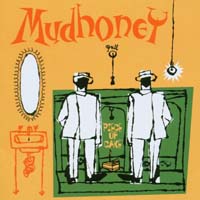Artist: Alice In Chains Album: Black Gives Way to Blue
Year: 2009Duration: 54:45
Going down memory lane with Alice in Chains' album: Black Gives Way to Blue
When it comes to rock music, Alice in Chains is a name that shouldn't be left unheard. Headed by Layne Staley and Jerry Cantrell, the Seattle-based band took the rock world by storm in the early '90s with their blend of heavy metal and grunge, going on to become one of the defining bands of the era. In 2009, after a hiatus of almost a decade, the band emerged with a new album, 'Black Gives Way to Blue,' which was praised for its raw energy and emotional resonance. In this post, we'll be taking a closer look at this album, examining its genre, the standout songs, and the most innovative parts, as well as offering our own critical evaluation.
Genre of the Album
Describing the genre of this album can be slightly complex, as Alice in Chains’ music often blurs the lines between various genres. Black Gives Way to Blue draws its influence mainly from grunge music – the brooding, heavy sound that characterized the early ‘90s, but it also incorporates elements of heavy metal, punk, and classic rock. The album features powerful, distorted guitar riffs and pounding drums, dealing with haunting and emotionally charged lyrics that are a staple of Alice in Chains’ music.
Standout Songs
The album is full of fantastic tracks, but there are a few that stand out above the rest. Your Decision, for instance, is a beautifully composed ballad-driven by melancholic lyrics and Jerry Cantrell's unforgettable acoustic riffs. Then there's Check my Brain, which gives off a sense of groove and swagger that's hard to come by in grunge music. The album's titular track, Black Gives Way to Blue, is another standout, with its haunting piano melody and deeply emotional lyrics, it serves as a heartfelt tribute to Layne Staley, the band's original lead singer who died in 2002.
Most Innovative Parts
What sets Black Gives Way to Blue apart from the other Alice in Chains albums is its newfound sense of hope, a quality that the band's early work sorely lacked. The album seems to be a tribute to Layne Staley, but it's also a declaration of survival and renewal. The addition of new lead singer William Duvall gives the band a newfound energy, which is evident in the album's more upbeat tracks. While the band maintains their signature sound on most of the tracks, the incorporation of piano ballads like the titular Black Gives Way to Blue shows their willingness to experiment with genres.
Critique of the Album
Critique of the Album
The only thing that might be lacking in this album is its cohesion. While every track has a quality of its own, the album can appear to be a collection of songs rather than a unified whole. However, the album is strong enough in its individual parts that this issue is easily overlooked. Additionally, it would have been interesting if the band could explore more genres and different instruments that could have added to the variability of the album.
Black Gives Way to Blue is an album that showcases the versatility and enduring appeal of Alice in Chains. The band's signature sound still thrills listeners, and the addition of William Duvall's vocals injects a fresh feel into the mix. The album ebbs and flows between darker and more hopeful themes, and is sure to remain an all-time favorite for many music enthusiasts.
Alice In Chains albums
Other #Grunge albums:
SIMILAR BANDS
balls, from 1 to 5, describe similarity between the two bands
SOMETHING NEW? LISTEN TO RADIOGENRE
 Dance pop
Dance pop House music
House music Progressive rock
Progressive rock Big band
Big band Reggaeton
Reggaeton Italian Trap
Italian Trap World Music
World Music Sardinia
Sardinia Latin rock
Latin rock Berlin Music Video Awards
Berlin Music Video Awards
SUGGESTED PLAYLISTS


































 The good America
The good America The very best of rap metal
The very best of rap metal The very best of electro pop
The very best of electro pop The music television
The music television The very best of industrial metal
The very best of industrial metal The very best of flamenco
The very best of flamenco The very best of ska punk
The very best of ska punk The very best of piano solo
The very best of piano solo The very best of electronica
The very best of electronica The very best of screamo
The very best of screamo